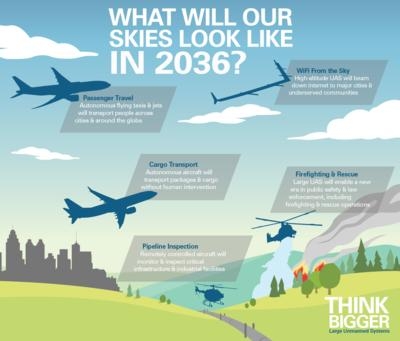Wed, Feb 28, 2018
Growth Seen As 'Explosive' Over The Next Two Decades
The Aerospace Industries Association, in partnership with Avascent, has released a study projecting explosive growth in the global market for large unmanned aerial systems (UAS) over the next two decades. The report, “Think Bigger: Large Unmanned Systems and the Next Major Shift in Aviation,” shows large UAS represent a cornerstone of future aviation, changing the nature of travel, technology and transport, and the economies surrounding those markets.

Specifically, spending on large UAS is expected to rise from the low hundreds of millions today to $30 billion annually by 2036, driven by manufacturing and services for long-haul cargo and passenger aircraft. The report also shows that spending will sustain up to 60,000 research, manufacturing and service jobs annually by the end of that timeframe.
“We have got to think bigger when it comes to the future of unmanned aviation,” said AIA President and CEO Eric Fanning. “The future unmanned systems market will change the way we travel and transport products. We could see entirely new economic centers where they don’t exist today. It’s an incredible opportunity, if government and industry start now on the regulations and technology to realize that potential.”
This new market requires U.S. regulators to adopt a posture that both ensures safety and fosters commercial innovation. Recommendations for maintaining U.S. leadership in this developing market include codifying near-term needs for detect-and-avoid operations, autonomous certification and spectrum allocation; international harmonization of regulations and performance-based consensus standards; and modifications of civilian UAS-related export and trade restrictions.
“The biggest barrier to growth is the regulatory framework,” Fanning said. “Global competitors are working to seize the market from the United States, the country that invented this technology. These are American jobs and American opportunities. But we must start now on certification standards, exports, and spectrum to ensure they stay American.”
(Source: AIA news release. Infographic provided)
More News
Aero Linx: JAARS Nearly 1.5 billion people, using more than 5,500 languages, do not have a full Bible in their first language. Many of these people live in the most remote parts of>[...]
'Airplane Bounced Twice On The Grass Runway, Resulting In The Nose Wheel Separating From The Airplane...' Analysis: The pilot reported, “upon touchdown, the plane jumped back>[...]
"Burt is best known to the public for his historic designs of SpaceShipOne, Voyager, and GlobalFlyer, but for EAA members and aviation aficionados, his unique concepts began more t>[...]
"Polaris Dawn, the first of the program’s three human spaceflight missions, is targeted to launch to orbit no earlier than summer 2024. During the five-day mission, the crew >[...]
There Are SO Many Ways To Get YOUR Aero-News! It’s been a while since we have reminded everyone about all the ways we offer your daily dose of aviation news on-the-go...so he>[...]
 ANN's Daily Aero-Linx (05.04.24)
ANN's Daily Aero-Linx (05.04.24) NTSB Final Report: Quest Aircraft Co Inc Kodiak 100
NTSB Final Report: Quest Aircraft Co Inc Kodiak 100 Aero-News: Quote of the Day (05.04.24)
Aero-News: Quote of the Day (05.04.24) Aero-News: Quote of the Day (05.05.24)
Aero-News: Quote of the Day (05.05.24) Read/Watch/Listen... ANN Does It All
Read/Watch/Listen... ANN Does It All



